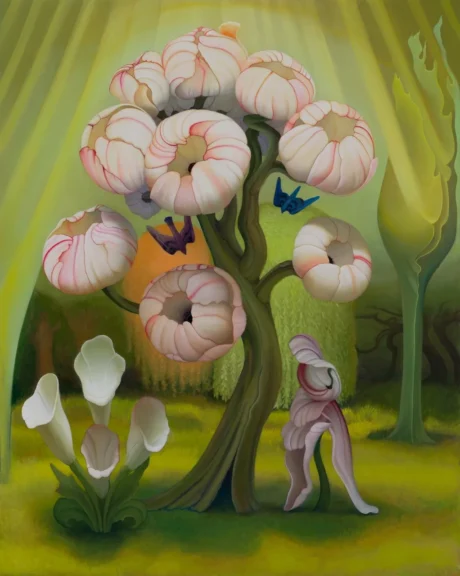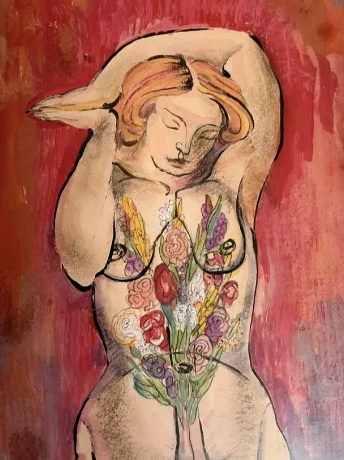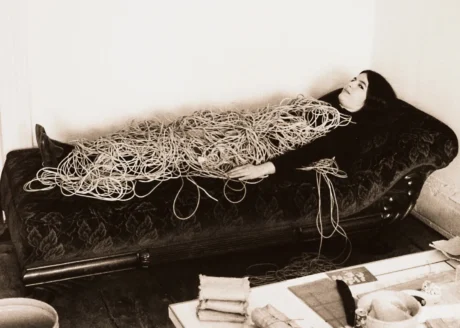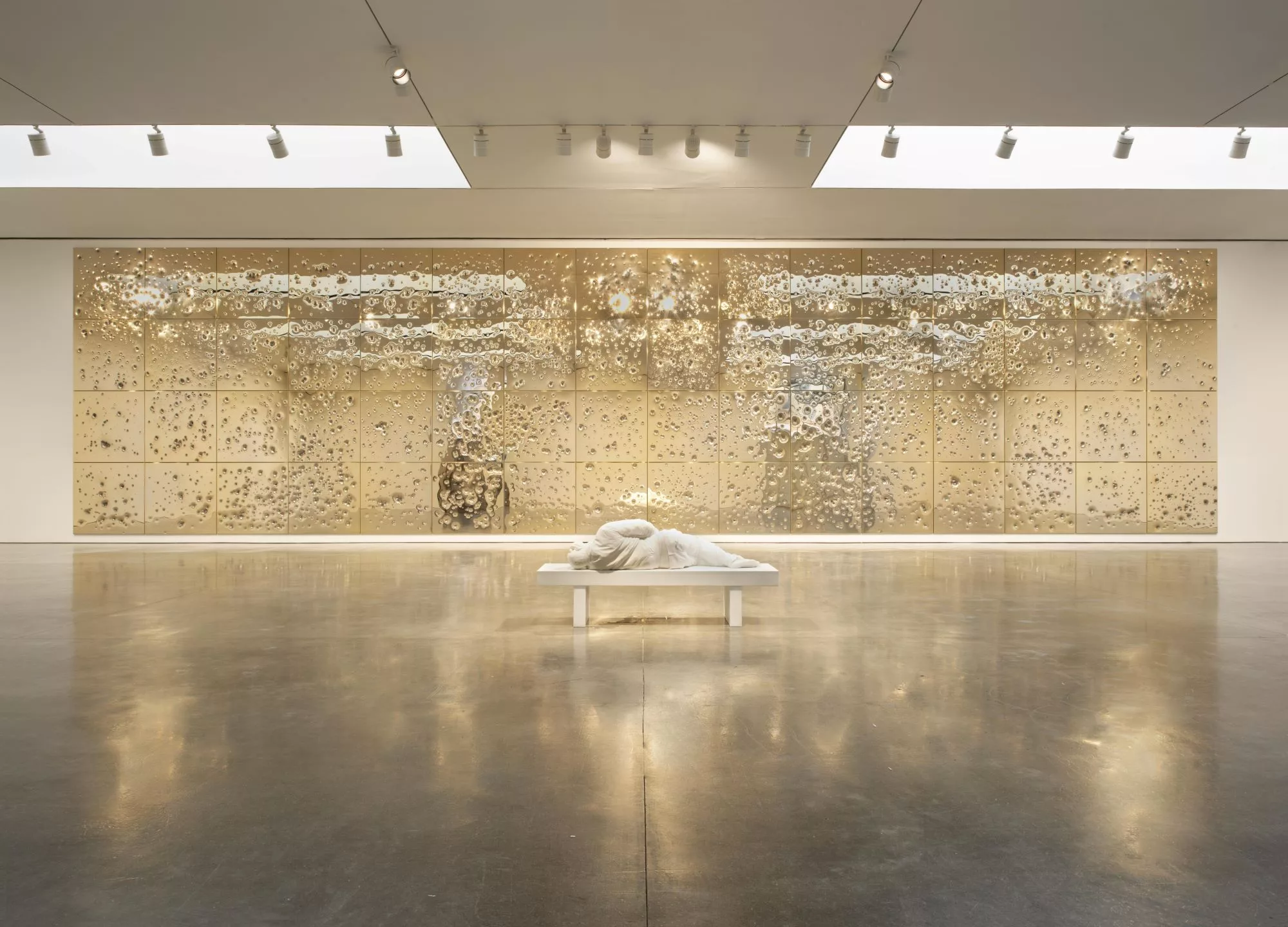
It’s a dreary, glum Tuesday morning in Chelsea, New York, and I’m waiting outside the entrance of Gagosian Gallery’s West 21st St. location for my editor. We were out drinking the night before to celebrate her birthday, a night I had to cut short for both of us as I didn’t want us to miss this opening. It was the first solo show for Maurizio Cattelan in two decades, titled Sunday. This was, on paper, the more important draw to the show. But what was more important for me was that it was the first press event Gagosian had invited me to since I first visited the gallery last year for their retrospective on the late Japanese artist Tetsuya Ishida. It was, in every sense, one of those shows that deepens one’s relationship with art. I enter the gallery, greet the staff, and begin to wander about.
I never like to read a press release before I enter a space because I’d like the explanation to come after the first impression. The wall of the gallery facing myself and the door, the longest in unobstructed width, is covered in floor-to-ceiling gold. It has been shot hundreds of times with bullets still visibly stuck inside of the façade. This piece is called Sunday. In front of it, I see a porcelain bench with a figure atop it, and what appears to be water is puddling on the ground below it. After observing the craters in the gold, I turn to look at the porcelain bench and realise that the figure atop the bench appears to have its dick in its hands, the source of the water that is puddling. I later learn that the piece is a fountain that is not draining anywhere. This piece is called November.
After my editor arrives, we share a smoke and complain about our headaches. She leaves. I read the press release. I go back in to speak with Gagosian PR for a moment and ask her more about the work. I leave. I text my editor-in-chief and tell her that I have no choice but to be honest in my review for this show, even if it means that I’m never invited back to Gagosian again.
Michelangelo Merisi da Caravaggio, born in Milan in 1571, is known now to the world as one of the greatest Italian artists to have ever lived. But when he ravaged the already sinister streets of Milan, he was known as a thief, liar, crook, bully, and murderer. After killing his rival Raniccio Tommasoni over a bet, he spent the remainder of his life on the run, beginning in Naples, where he first established himself as one of the greatest painters of his time. In spite of his outrageous lifestyle, his genius and talent carried him into the hearts of wealthy donors and lovers of art. It could be argued that his fantastic and dastardly nature contributed to his success, for his art never strayed too far from the realities of his life.
Take, for example, the masterpiece Calling of St. Matthew (1599-1600), a depiction of Christ’s indoctrination of the tax collector Matthew. In it, we observe a scene enveloped in blackness, as Caravaggio is known for, where seven men are gathered in a dark, dank bar, wearing contemporary clothes—five are sitting at a table, two standing, one of them pointing at the table, a ray of light above him, supposedly Christ. All of them, including Christ, are dressed in contemporary clothing and are believed to be modelled after the same comrades and drunks from Caravaggio’s life in Milan.
Though he is depicting a biblical scene, normally shown with bright colours and ethereal figures, Caravaggio is penetrating through the outer bubble of the Renaissance era into the Baroque with the grotesque, startlingly lifelike interpretations of Christian figures through the rawness of Italian reality. There’s an almost assaulting intimacy with scenes believed too sacred to share in likeness with physically available mortals. He is reducing the distance from the divine, represented by the untouchables, and forcing man to contend with his own closeness with a believed impossibly distant lord. The painting is a dirty mirror that won’t clean in the house of God.
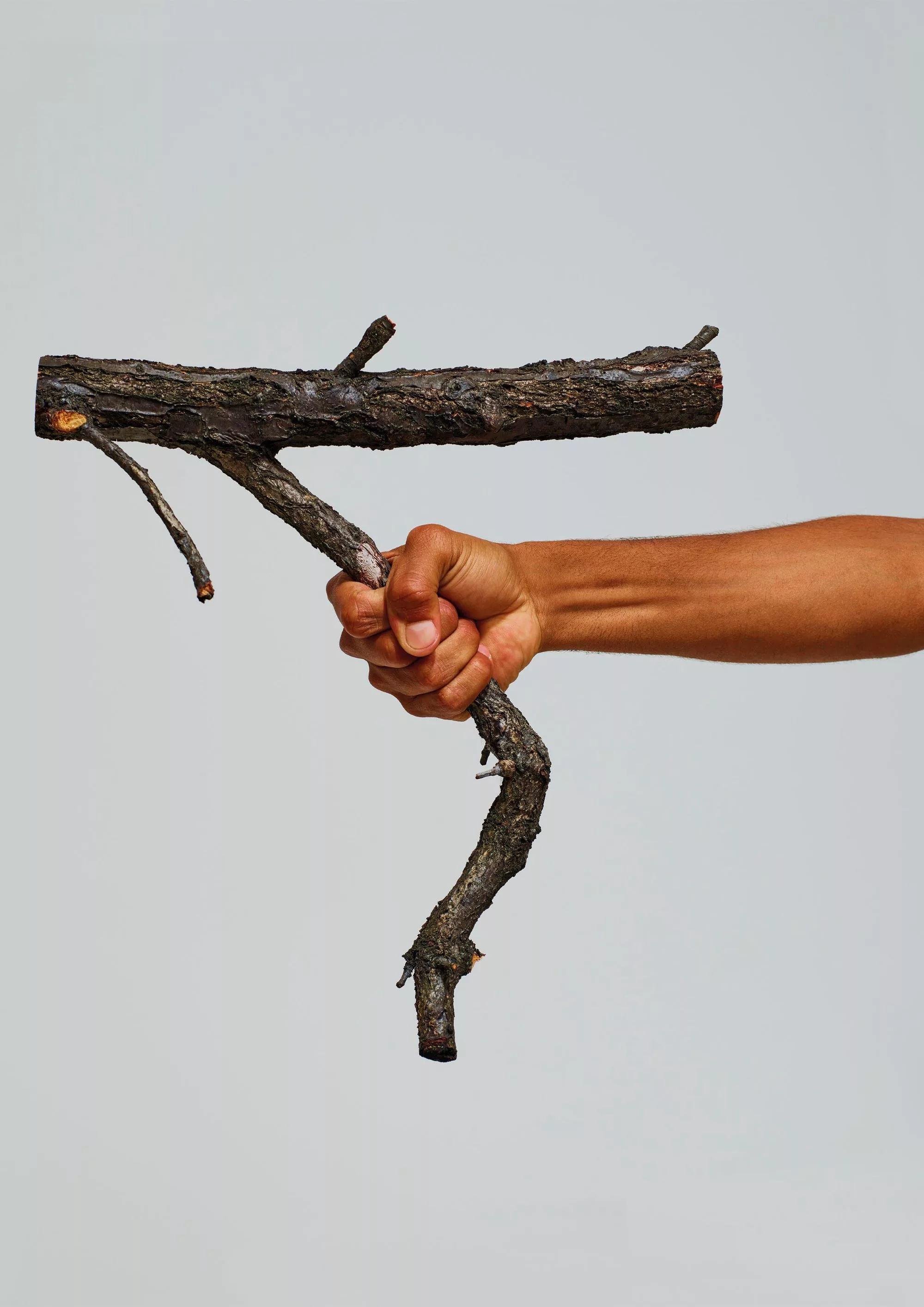
And there is perhaps only one artist since Caravaggio who has successfully reembodied Caravaggio’s degradation of etiquette toward higher power, the Italian conceptual artist Maurizio Cattelan. There are many such examples of Cattalen’s employment of the “dirty mirror”: his miniature wax figure of a kneeling Hitler in Him (2001) and his incredibly controversial depiction of Pope John Paul II struck by a meteorite in La Nona Hora (1999). But I believe there’s no work that so shatters the stairway between Earth and Heaven than Now (2004), his depiction of a cold, grey, lifeless John F. Kennedy, barefoot in an open casket. Made after 9/11, Cattalan wanted to depict the death of hope that was felt when the President died as was present after the attack on the World Trade Center (Cattalan walked from JFK Airport to Manhattan after his flight out of town was cancelled on September 11th).
But I was introduced to Cattelan (as probably most people aware of him were) by Comedian (2019), the banana duct taped to the booth wall at Art Basel Miami that started a national conversation over what art is. I remember reading about Comedian in my college bedroom during my senior year. I thought it was one of the most brilliant works of art I had ever seen, and it remains cherished by me because this was before I knew practically anything about fine art. I hold this impression dearly for the same reasons I don’t read press releases before I walk into a show: I don’t need to like art, but I want to love art.
So herein lies my disappointment with Sunday. I remember telling someone that Sunday felt like something I would think of as a fourteen-year-old, recently radicalised by my history teacher. “If I had millions of dollars, I’d take a bunch of gold and shoot it.” A mediocre, childish, pedestrian depiction of gun violence. And as for November, the fountain felt ugly, gross and wrong. At a time when homelessness is at an all-time high in America, when countless cities across the country are electing to outlaw homelessness over investing in rehabilitation or housing, it felt disgusting to make art that seemed to humiliate an already vulnerable and forgotten part of society. And to be doing so with such an audience, the wealthy and elite of New York, at the most valuable art gallery in the world. What was the point? Imagining the work in someone’s home made me feel nauseous.
Knowing that this was Cattelan’s work gave me a great pause. This was not the work of some out-of-touch artist pandering to the elite, or at least he was not such a way at one point in time. Why would he do this? What was the point? What was it beyond a superficial, simplistic depiction of “America?” It felt so obvious. It felt too easy. Of course America is these things, but why show them in this way? Why attack the common man?
I began to obsess. I watched his documentary. I read every article I could find on him. And I kept discovering the same thing: he was a genius intent on exposing the cracks in society. He was a man of the people who employed his own life experience to make art that was immediately consumable in its obvious technical brilliance but so much more layered in its messaging. He was a magician, or perhaps a thief, stealing the attention of unsuspecting, overly pretentious audiences ready to draw conclusions over his work while not understanding the meaning was in our reaction, not in the work itself.
He was Caravaggio. And I couldn’t let it go because I love Caravaggio, and for the same reason, I love Cattelan. Anyone can love Caravaggio. I loved Caravaggio before I knew anything about art. When I saw Caravaggios in museums or when I learned about Caravaggio in school. He was a figure that could not be contained by history, so he had to create it.
So, why, then, would Cattelan make such work?
Since then, I have been reflecting on the work he showed previously in Milan in 2004, “Hanging Children,” in which he hung three wax figures of young boys from a tree. The local community cried out in anger against the work. Someone attempted to cut the figures down and injured themselves in the process. It was, to many, a similar point of a work having gone too far.
Except, according to the documentary on Cattelan, Be Right Back (2006), a local mother wrote an open letter to the community about the works and pinned it on the tree the figures hung from, saying that the work, although disturbing, had brought attention to the dangers local boys faced in the community. Then, someone else wrote a response to the letter on the same page. Then another. Then another.
Discussion. Debate. Conversation. Are these not the tenants of what elevates a piece from beautiful to important? Is not learning from a work more valuable than enjoying it?
At least, this is what I repeated to myself, over and over again, in the days after I saw Sunday and November. There must be a reason I couldn’t stop thinking about them. There must be a reason that I wasn’t satisfied with my anger at work. Is this how Valerie Solanas felt when she thought about Andy Warhol? Why couldn’t I stop thinking about these works?
The morning of the day I set out to finish the piece, I got on the phone with my friend Danny Cole, an artist himself who deals in attention-grabbing stunts, some of which I have participated in. And I told him about November, my anger at the work, the disdain it depicts for homeless people and the dignity that it lacks.
“How do you know it’s meant to be insulting?” He asked. Well, I responded, it’s showing a homeless person with their dick out, pissing onto the floor. How could it not be humiliating? “Everyone has to piss,” he responded. “It’s your choice whether or not to look.”
It shook me. I hadn’t thought about that at all. The figure was faced away from the gallery entrance. It’s your choice to walk around it and invade upon its privacy, turning your back to the gold façade and looking down upon the figure.
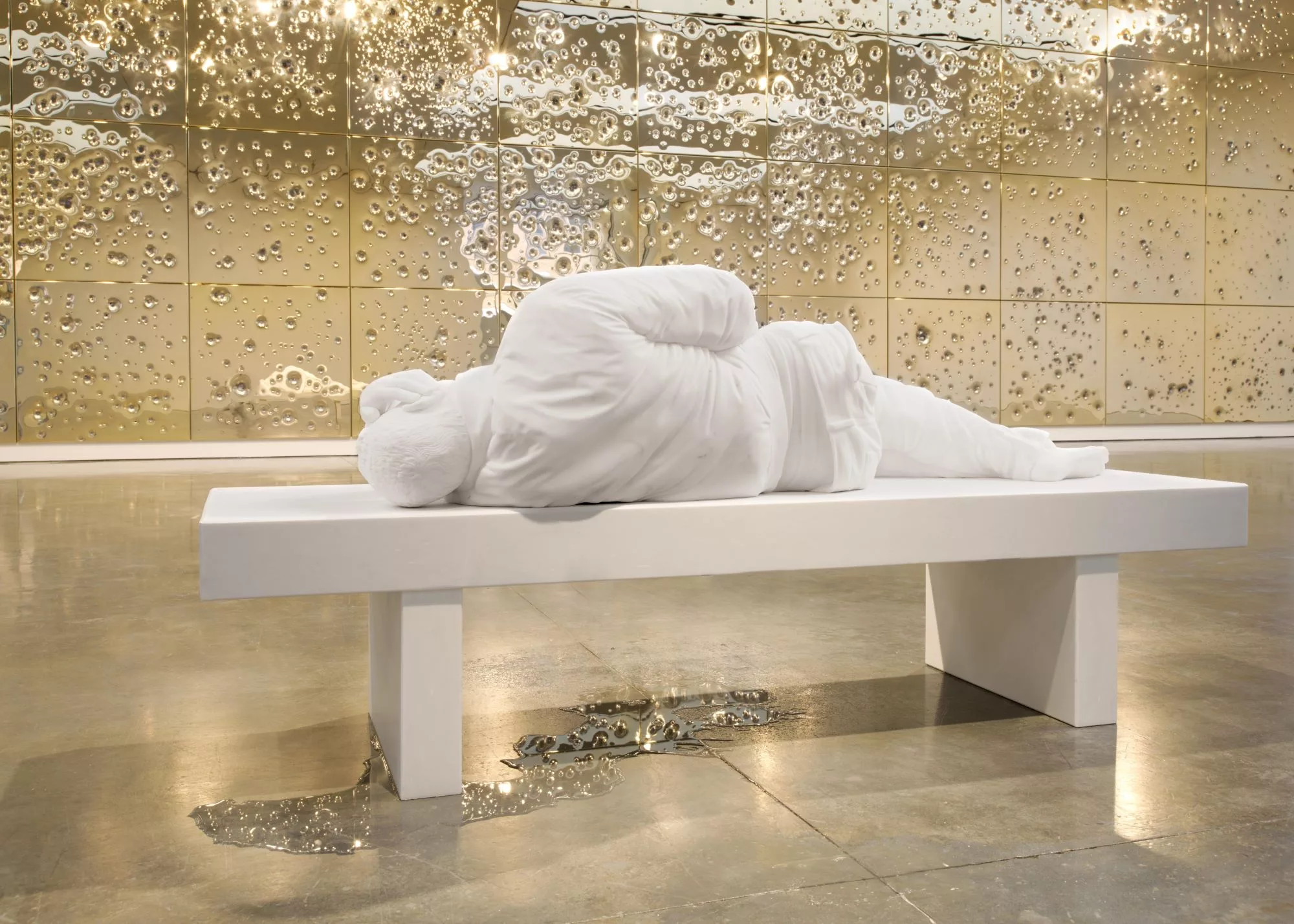
And why was Sunday so much easier to look at than November? Real bullets shot into this gold, into this mirror, staring back at you, confronting you with an accusation of violence. It feels like almost every day, there is another mass shooting in America—maybe it’s easy to look at because it’s become just as easy to gloss over the same headline. Even the finest objects and the finest people aren’t immune to the threat of a bullet. Yet onlookers seem undaunted. The value of the gold remains the same, even if it is filled with harm. And facing the façade behind you as you’re observing yourself, November, pissing on the floor you walk on, unafraid to face itself, unobstructed by your presence. You’re so concerned with your reflection that you ignore the figure behind you, dick out, urinating. It’s all one image.
I finally realised why these two works faced each other: when you stand between them, you see two sides of America. Yes, it felt obvious from its beginning. But, as I said, that was what was so brilliant about Cattelan’s work. It’s meant to be immediately consumable because the art is not in the work but rather how you react to it. I was more disgusted by the idea of the bad faith assumption that this figure was meant to make fun of homeless people when, in reality, it was making fun of me and asking me, “Why are you looking? Why do you feel so comfortable imposing upon me? And why is it so much easier for you to laugh, in discomfort, at this than this giant display of gold shot with a deadly weapon? Why do you feel so above these depictions? Why is one of them supposedly more offensive than the other? Why does one of them make you more angry than the other when both of them are an everyday reality in America? Because it’s an art gallery, does that make you feel safe? Just because you’re not here to buy, does it make you any less complicit in these realities?
You turn away from the dirty mirror, and you face another.
Whether or not I like the work, I am still unsure.The idea of the piece in the home of a wealthy art dealer is deeply unsettling. A testament to the isolation and casting out of those living on the street remaining forever in the presence of a person who, more than likely, will never pay anywhere close to the same respect to a member of society that the work is meant to depict. It makes me wonder why Cattelan didn’t depict the figure in the piece with the same respect as he did JFK in Now or Hitler in Him.
But maybe he did it for the absurdity of it. Maybe he knew it would make people laugh, like depicting Christ and his disciples as bar dwellers and fiends—depicting the everyday reality of New York, of America, as a porcelain fountain, staging it in the most expensive art gallery in the world. It’s a reduction of distance from the divine, taking the common man, the man without power, and having him literally piss on the floors the most powerful have made their home.
Written by Saam Niami

